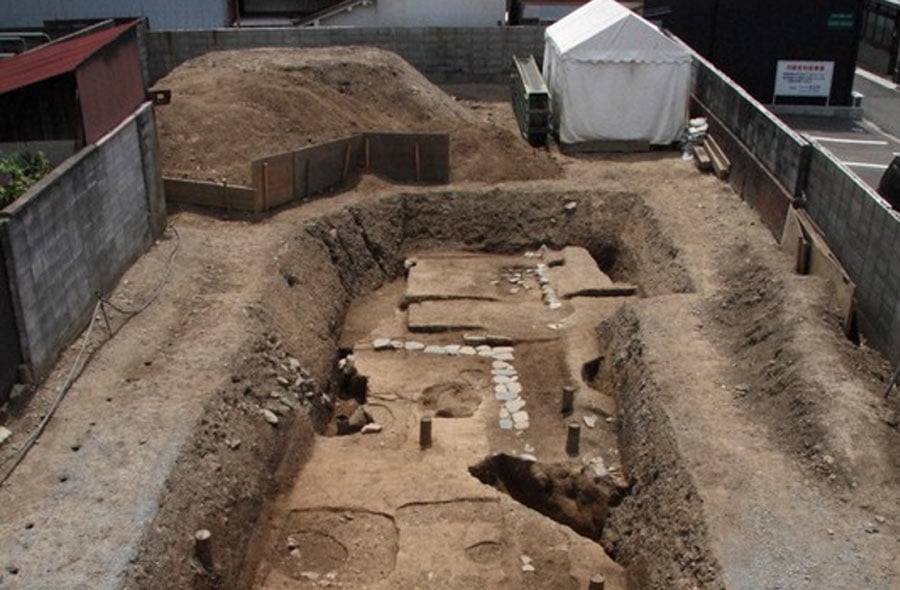Five Post Holes Reveal Legendary Japanese Empress’s Royal Pavilion.
A team of Japanese archaeologists have discovered what they consider to be the remains of is the legendary Tokaden royal pavilion. Until the early 8th century the Japanese court was peripatetic, meaning it moved from place to place. In the mid-9th century, increasing populations and subsequent imperial bureaucracy, required the building of the first centralized imperial capital cities. And it is in this historical time period that the Tokaden royal pavilion, which has just been identified, was built.

This complete picture of the royal pavilion foundation found in ancient Kyoto, Japan, which shows the 5 post holes: four on the left and one in the lower right. (Kyoto City Archaeological Research Institute)
Five Post Holes Identified The Japanese Royal Pavilion
The excavations took place at Kyoto on Japan’s main island of Honshu. The ancient Japanese capital and administrative center of Heian-kyo (modern Kyoto) was established by Emperor Kanmu (or Kammu) at the beginning of the Heian period (794 AD), which lasted until 1185 AD when the dynasty collapsed and Japan’s first shoguns set up their military capital at Kamakura, just west of present-day Tokyo.
- The Heian Era: Golden Age of Japan’s Imperial Court
- Hachiman: Deified Emperor, War God, Protector Of The Japanese People
The discovery of the elaborate ancient Tokaden royal pavilion dwelling that was built for an empress and her female palace attendants, represents one of 17 similar structures that comprised the emperor’s private residence. It was back in 2015 that researchers from the Kyoto City Archaeological Research Unit first discovered five postholes in the city's Kamigyo Ward, and it was these five massive, waterlogged features that ultimately led to the identification of the Tokaden royal pavilion.

A scene from the Heian era, the period in which the Tokaden royal pavilion was built, showing the life of the early imperial nobles of Japan as depicted in the Tale of Genji novel by Murasaki Shikibu. (Tosa Mitsuoki / Public domain)
When Fiction Holds Kernels Of Truth, Magic Happens
The five post holes measured between 1 and 1.5 meters (3.3-4.9 feet) in diameter, and they were situated about 2 to 3 meters (6.6 to 9.9 feet) apart, in a north to south orientation. The Mainichi reports that to identify their discovery the archaeologists referred to descriptions of the Tokaden pavilion found in Heian-period literature including The Tale of Genji written by Murasaki Shikibu and The Pillow Book, recorded by Sei Shonagon.
The two ancient texts describe the emperor's private residence as measuring “182 meters (597 feet) from west to east, and some 226 meters (741 feet) from north to south, comprising 17 pavilions, among other structures.” The Tokaden pavilion is described as extending about 12 meters (39 feet) from west to east and about 27 meters (89 feet) from north to south. Thus, the archaeologists are near certain they have discovered the key post holes for the, until now, legendary pavilion.

Heian Shrine in Kyoto is smaller scale replica of the imperial capital’s first imperial palace, which was built at the same time as the Tokaden royal pavilion remains recently discovered in the city. (SeanPavonePhoto / Adobe Stock)
Ancient Building Foundations Reveals Secrets
According to the investigation report the five post holes were used to “bury pillars in the ground without placing foundation stones.” It was this observation that would become a key clue in associating the building with the earliest days of Heian-kyo.
The researchers identified a section of stones forming an L-shaped ditch in the southwest corner of the Tokaden, and a similar ditch in the northern part of the neighboring Kokiden royal pavilion. It is thought that these features were built in the 10th century and coursed heavy rainwater from the roof, like a modern gutter. They also unearthed a large foundation stone between the stone ditches, which may have formed a corridor connecting the two buildings.
The scientists believe the two ditches date to the early 10th century and that they are remains from two centuries after the original building was rebuilt, and that the supporting pillars had been secured on heavy foundation stones.

The 6th-century Gango-ji Gokurakubo Temple in Nara, the previous imperial capital before Kyoto, shows how Japanese architecture looked at the time. (Bernard Gagnon / CC BY-SA 3.0)
One Of The Earliest Royal Pavilions In Japan
The researchers knew that Emperor Kanmu, who established Japan's capital at Heian-kyo in 794 AD, followed Tang Dynasty culture imported from China. Tang architects always designed pavilions by placing pillars on foundation stones, and they never deviated from this building style.
Because the posts were not placed on foundation stones at this newly discovered site, this building most probably dates to the capital city’s very earliest days, before the influences from China changed many things. The scientists concluded that the Japanese traditional method of “not using foundation stones” was also adopted for the builds that were used for Heian-kyo’s first imperial palace or Heian Palace.
- The Amazing Ascent of the Japanese Shoguns from 1192 to 1867
- Medieval Japanese Weapons Influenced Culture Long After the Middle Ages
The five post holes represent the first time that architectural remains from the Heian-kyo imperial residence have been discovered, and they are believed to have been dug out around the time the capital city was moved to Heian-kyo, at the end of the 8th century.
Top image: The outlines of the legendary but lost royal pavilion of Kyoto known as the Tokaden pavilion, which was built in ways that were still different from Tang dynasty Chinese foundations. Source: Kyoto City Archaeological Research Institute
By Ashley Cowie



















